
Carpenter bees are species in the genus Xylocopa of the subfamily Xylocopinae. The genus includes some 500 bees in 31 subgenera. The common name "carpenter bee" derives from their nesting behavior; nearly all species burrow into hard plant material such as dead wood or bamboo. The main exceptions are species in the subgenus Proxylocopa; they dig nesting tunnels in suitable soil.

Rhopalosomatidae is a family of Hymenoptera containing about 68 extant species in four genera that are found worldwide. Three fossil genera are known.

Xylocopa virginica, sometimes referred to as the eastern carpenter bee, extends through the eastern United States and into Canada. They are sympatric with Xylocopa micans in much of southeastern United States. They nest in various types of wood and eat pollen and nectar. In X. virginica, dominant females do not focus solely on egg-laying, as in other bee species considered to have "queens". Instead, dominant X. virginica females are responsible for a full gamut of activities including reproduction, foraging, and nest construction, whereas subordinate bees may engage in little activity outside of guarding the nest.

Xylocopa violacea, the violet carpenter bee, is the common European species of carpenter bee, and one of the largest bees in Europe. It is also native to Asia.

The Republic of the Congo, also known as Congo-Brazzaville, the Congo Republic or simply either Congo or the Congo, is a country located on the western coast of Central Africa to the west of the Congo River. It is bordered to the west by Gabon, to its northwest by Cameroon and its northeast by the Central African Republic, to the southeast by the Democratic Republic of the Congo, to its south by the Angolan exclave of Cabinda and to its southwest by the Atlantic Ocean.
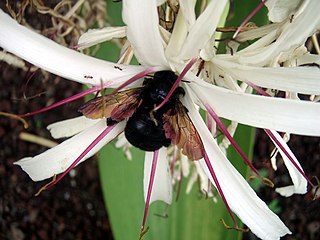
Xylocopa sonorina, the valley carpenter bee or Hawaiian carpenter bee, is a species of carpenter bee found from western Texas to northern California, and the eastern Pacific islands. Females are black while males are golden-brown with green eyes.
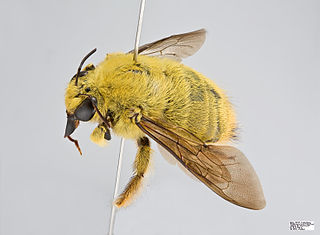
Xylocopa caffra is a species of Afrotropical carpenter bee that ranges from west to central and southern Africa, besides Madagascar and some Indian Ocean archipelagos.

Xylocopa caerulea, the blue carpenter bee, is a species of carpenter bee.

Xylocopa aestuans, or Xylocopa (Koptortosoma) aestuans, is a species of carpenter bee. It is widely distributed in Southeast Asia.
Xylocopa amethystina, or Xylocopa (Nodula) amethystina, is a species of carpenter bee. It is distributed in South Asian countries such as, India, Pakistan and Sri Lanka.

The Oriental carpenter bee, Xylocopa nasalis, or Xylocopa (Biluna) nasalis, is a species of carpenter bee. It is widely distributed in Southeast Asian countries. It is a major pollinator within its ecosystem, and is often mistaken for a bumblebee. The species leads a solitary lifestyle with a highly female-biased colony in the nest.
Xylocopa tranquebarica, or Xylocopa (Nyctomelitta) tranquibarica, is a species of carpenter bee. It is found only in South Asian and Southeast Asian countries. It is a nocturnal bee.

Xylocopa augusti is a species of carpenter bee.

Xylocopa olivacea is a species of carpenter bee. It has a completely yellow thorax and a yellow band on the first tergite. This species is very similar to X. calens, endemic to Madagascar. X. calens just differs in the length of the hair on the metasoma.

Xylocopa inconstans is a species of carpenter bee.
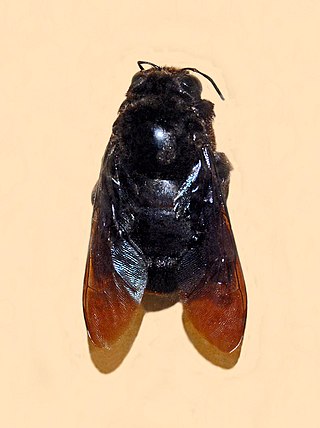
Xylocopa combusta is a species of carpenter bee.
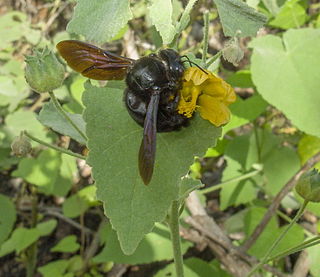
Xylocopa darwini, the Galápagos carpenter bee, is the only native species of bee in the Galápagos Islands, to which it is endemic. Altogether, only three species of bee are found in the islands. This species found on 75% of the largest islands. It is sexually dimorphic and is known for its complex behavior. As the only native bee, Xylocopa darwini serves as an important primary pollinator within the plant-pollinator network of the archipelago.
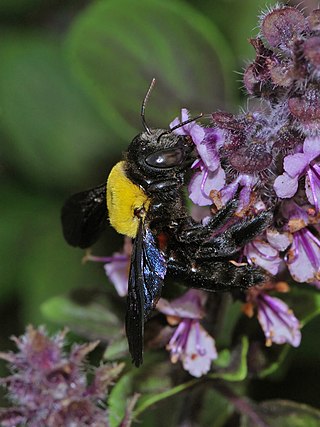
Xylocopa pubescens is a species of large carpenter bee. Females form nests by excavation with their mandibles, often in dead or soft wood. X. pubescens is commonly found in areas extending from India to Northeast and West Africa. It must reside in these warm climates because it requires a minimum ambient temperature of 18 °C (64 °F) in order to forage.

Xylocopa micans, also known as the southern carpenter bee, is a species of bee within Xylocopa, the genus of carpenter bees. The southern carpenter bee can be found mainly in the coastal and gulf regions of the southeastern United States, as well as Mexico and Guatemala. Like all Xylocopa bees, X. micans bees excavate nests in woody plant material. However, unlike its sympatric species Xylocopa virginica, X. micans has not been found to construct nest galleries in structural timbers of building, making it less of an economic nuisance to humans. Carpenter bees have a wide range of mating strategies between different species. The southern carpenter bee exhibits a polymorphic mating strategy, with its preferred method of mating changing as the season progresses from early spring to mid summer. Like most bees in its genus, the southern carpenter bee is considered a solitary bee because it does not live in colonies.

Hyptia is a genus of ensign wasps in the family Evaniidae. There are at least 50 described species in Hyptia. Most Hyptia can be differentiated from other genera by heavily reduced venation of the forewings, wherein only one closed cell is present.

















